A Weekend Trip To Memphis, TN
The historically rich past casts a long shadow over present day Memphis.
I walked through the upstairs hallway that felt like a dilapidated tenement house – single lightbulbs hung from the high ceiling, creaking floorboards, paint peeling from the scrawled upon walls, and holes punched through drywall. There were several doors on the right side, some padlocked shut, others wide open. In them were mismatched dining and living room chairs, maybe from the previous era when this was a brothel, possibly the half-assed design work of the staff running two bars in one: Earnestine & Hazel’s downstairs, and Nate’s Bar at the end of this dark hallway.
Stepping into Nate’s you hit the small L-shaped bar that has about 3 or 4 seats on each side. The far side is snug along the windows, overlooking the corner of Main & Patterson. The attached room is adorned with Christmas lights, two tables, and a white piano in the corner. The aesthetic is like the hallway, though the chipping paint gives way to exposed brick and there’s some pictures and art on the wall. The room was full of smoke. Yessir, you can smoke inside bars in Tennessee. The south is alive and well.
The drink selection is minimal at Nate’s and there’s not a menu. It made me feel out of place, but I navigated my uncertainty by picking from the slim selection of bottles sitting atop the bar. I asked Nate himself for a Crown neat, a drink I have never ordered before. I handed him some cash (it’s cash only) and he waved it off “He’s got you,” pointing to a black man sitting alone in the far corner of the bar. I gave him a smile and a nod - it was a $9 drink, so not exactly insignificant to buy a total stranger.
I sat at the piano, the only vacant spot available, feeling pretty goddamn good about myself. I’d gone from out of place to getting comped a drink in the blink of an eye. Despite being all alone at a strange bar, I was getting drinks from the regular in the corner. Surely, I was this cool. After all, I was sipping Crown out of a plastic shot glass. Awash in confidence, I observed the bar patrons, it was a fun, mismatched crowd.
It was very mixed, with a lot of smokers – young and old, black and white, one couple, a few groups, and a couple stragglers like me. There were two distinct groups of post-fraternity, good ole boys chatting about all things college football. The group nearest to me drew the attention of a few heftier, jovial women, likely not far removed from their own days at the sorority house. The boys plan seemed to be taking them to Little Rock the next day and the women wanted in.
As space at the bar opened, I ordered a beer and went to thank my man for purchasing me a drink. I offered to get him his, but he pointed to his nearly full high ball as he lit a fresh Black & Mild. He told me when he walked in someone had bought his drink and he was “just paying it forward.” Like that, we were chatting and the idea of paying it forward quickly drifted into race. Memphis has been entrenched in every issue of race since its earliest days, how could it not come up?
His name was Michael but went by Guru. That’s what Nate called him anyway. We chatted for a while, he tried to convince me to ride motorcycles and told me about the 24-hour rides he and his friends would take from Memphis to Arizona. But eventually we were back on race and the phrase he came to – at 1:15 a.m. with our buzz tied on and the crowd thinning out – was “color doesn’t matter, it’s how you are with me.” Straightforward and to the point, I agreed whole heartedly. Right in line with any basic and good religious tenants before they’re twisted by dirty practitioners.
For an introduction to Memphis, Guru was just the person I wanted bending my ear. He personified two of the pervasive qualities that came to be intertwined with my understanding of Memphis: an over-the-top friendliness (without the southern formalities that often make it feel like an inauthentic ritual) and a constant state of reconciling a racially brutal past that persists today.
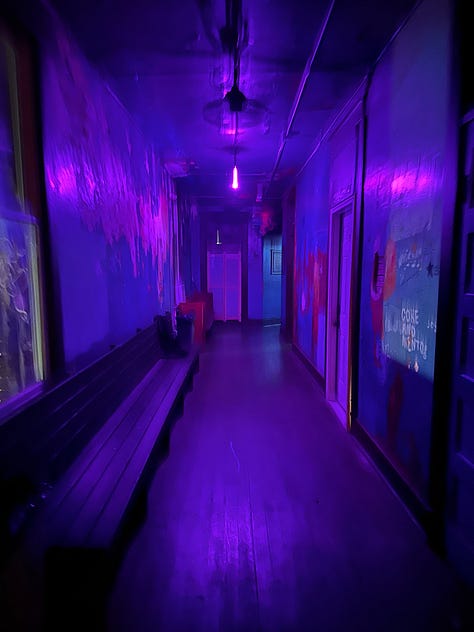
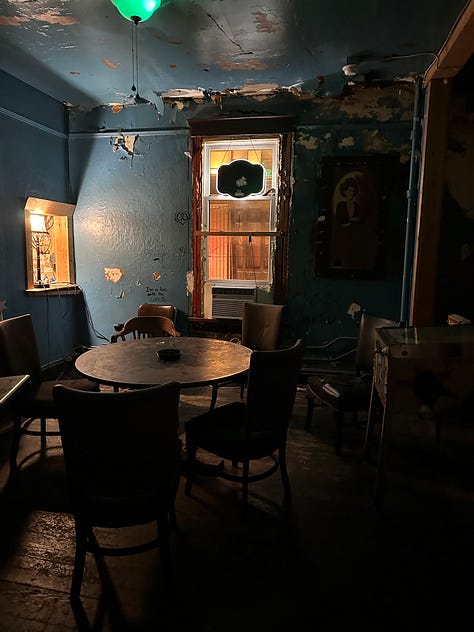
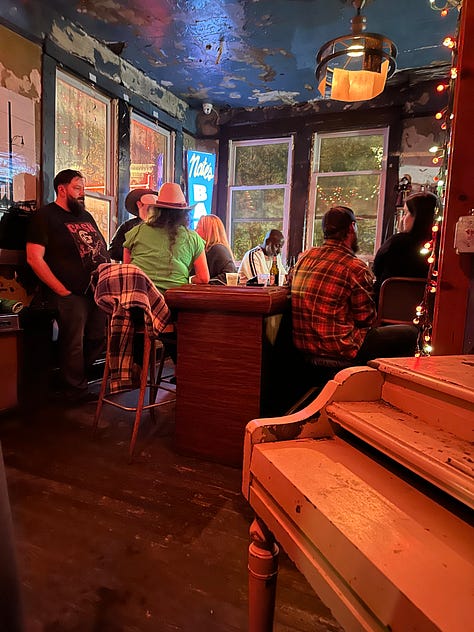
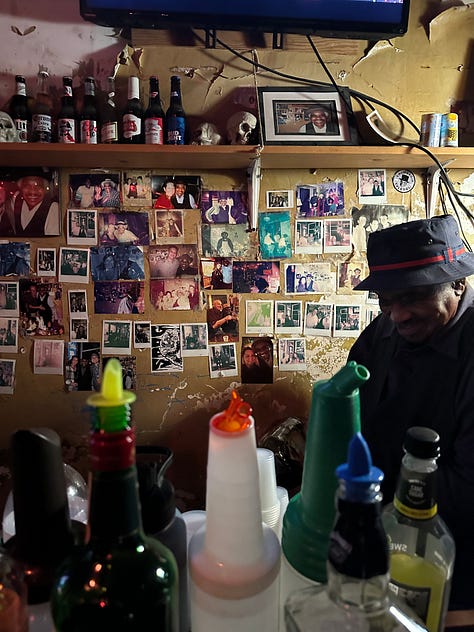
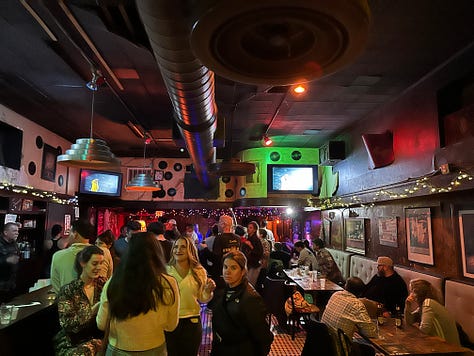
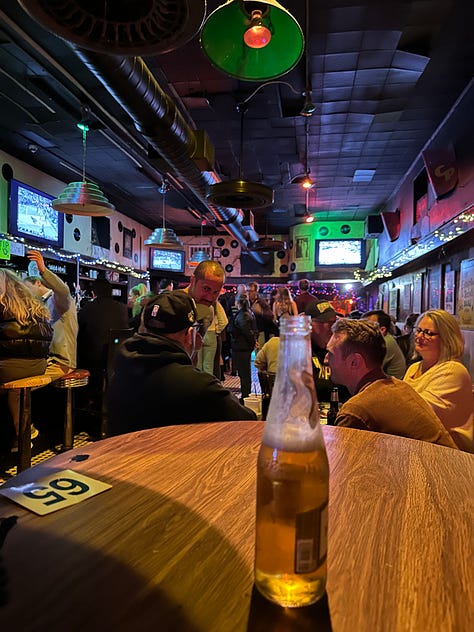
A few hours prior I’d landed at Memphis International Airport. I was shocked at how modern it was for a small market city until I remembered it’s the hub for FedEx, and the busiest cargo handling airport in the world. Even without a lot of pedestrian foot traffic, they completed a renovation in 2022 that made the passenger concourses pristine. This stuck with me as I started exploring the city because once in Memphis, you’ll feel like you’re in a variety of different eras, none of which could be considered contemporary.
After dropping my bags, I immediately hit the town. The first stop: Beale Street. Why? Because I think you should at least see the tourist haven. And why not set the bar so low that the rest of the city can show off? Beale Street – a mecca for blues in the first half of the 20th century, is today, the equivalent of Bourbon Street . Overpriced bars, cover bands, alcohol flowing freely on the open street, and tourists. But unlike Bourbon, not that many tourists.
It was Friday at 10p.m. and it felt desolate. Was this just how Memphis felt or was it the fact that I planned my trip over the same weekend as the Holy Convocation for COGIC – the Church of God in Christ? If the 35,000 people that attended the convention were partying, it wasn’t happening on Beale Street. Was the city actively avoiding them or joining them in possible abstinence? While cruising the strip I saw the Absinthe Room, so I had a namesake drink and wasted little more time on Beale.
I made my way to Earnestine & Hazel’s, the most hyped of the dive bars in town. I’m often skeptical of this. A supposed dive bar with a ton of popularity often means fewer locals spend nights there and it becomes the surrogate for an “authentic” experience for out-of-towners. Still a big step up from Beale Street, but not exactly mixing it up at a hidden gem. But sometimes hype worth it. And I’ve found that same buzz in a smaller city doesn’t necessarily ruin a place the way it does in a big city.
The adoration for E&H begins with the history, which Thrillist and Vice do great write ups of, so I don’t have to. The gist is, it’s well over 100 years old, with many iterations including a club downstairs and a brothel upstairs, patronized by the likes of BB King, Sam Cooke, Bo Diddley, Ray Charles, Chuck Berry, and others. Ray Charles was known to shoot up in one of the rooms off the long hallway to Nate’s. And Ghost stories abound here. Just google it. Since ’92 it’s been the current iteration: a dive bar serving just one meal (soul burgers with a bag of chips), live music most nights, and Nate’s upstairs providing a secondary bar and vibe. While it feels entirely too cool and known to be a true dive at this stage of is existence, it’s divey. And like any good neighborhood joint, they cater to all crowds. The age range was easily the college kid with a fake ID up to 75-year old’s looking for a quick bite and beer. And like any place in the south, if it’s not a strictly black or white crowd, it’s as mixed as it gets.
There’s a long bar on the left stretching most the distance of the building with a staged tucked into the back corner and bathrooms on the right. The rest of the room is filled with tables and an open space for dancing. When I arrived at 11p.m. it was starting to fill out, by 12:30a.m. it was slammed.
I sat at the bar watching the grill master do his thing – working 10+ burgers at a time – flipping, saucing, cheesing, and heating buns in blissful unison. He wore over-ear headphones and bopped his way through the night ignoring the live music and crowds. While the band played early 50’s era rock, a drunk woman wiped out on the dance floor. It stopped the show. In fact, it was so bad that both bartenders and the bar-back left their stations to tend to the mop job. It was gnarly and perfect. By the time I left Nate’s, it was 1:30a.m., drunk and full.
My night had already begun with two great Lyft drivers. Jennifer picked me up from the airport. When I asked for her favorite BBQ spot she said, without any air of pretension, “I don’t have a favorite, I make my own.” And Demetria who took me to Beale, blasted R&B and had bubblegum and candy air-fresheners circulating throughout the car. The culture shock from Portland was instant. When I mentioned Earnestine & Hazel’s, she told me “Ohhh yeah, me and my girlfriends go there sometimes. That burger is good, they give it to you with a bag of chips. You gotta put the chips on it.” Noted.
Now leaving Nate’s, I was blessed with yet another great Lyft driver, Robert. He was a supremely southern white guy; his accent was thick with his own little stutter like maybe he’d had a few drinks too. He told me about his own weird experiences with the COGIC church – a pastor calling out people in the crowd by name and airing their dirty laundry. When his navigation ended my ride at a gas station, he was confounded.
“Wait wait. What? This is your destination. You’re going to a gas station?”
I told him I needed some drinks and snacks for my place.
“Ah hell man, I’ll just pit stop for ya, get what you need, and I’ll get you home.”
The southern hospitality is real in Memphis.
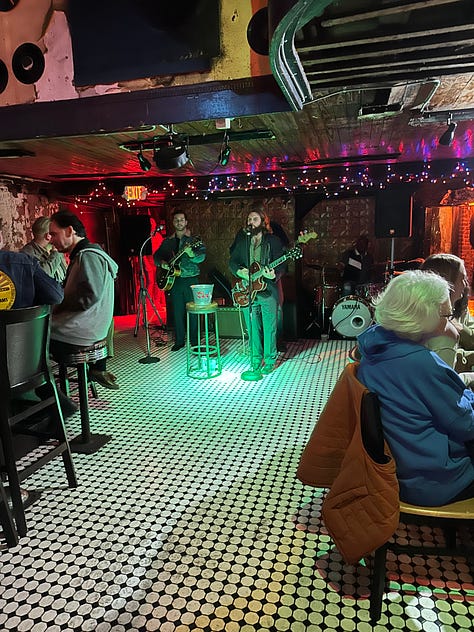
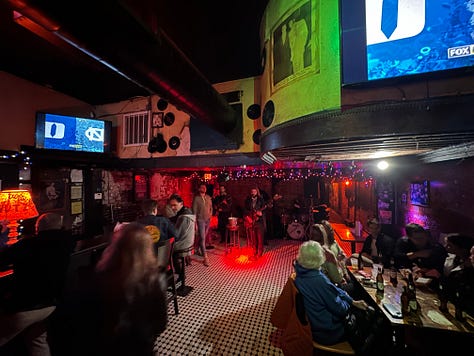
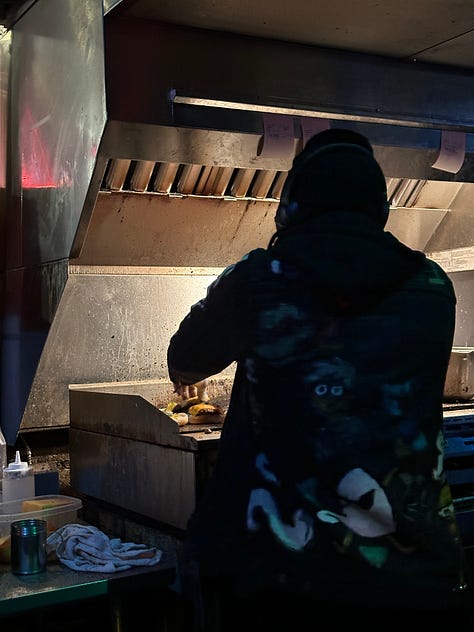
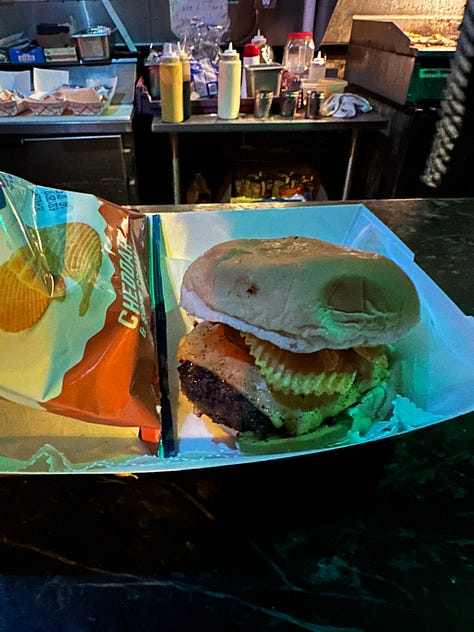
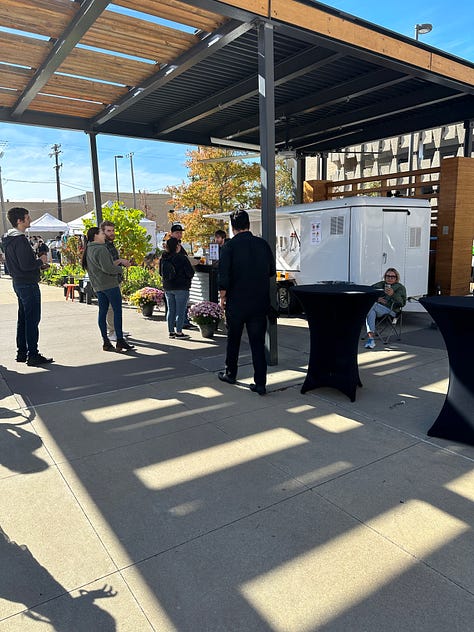
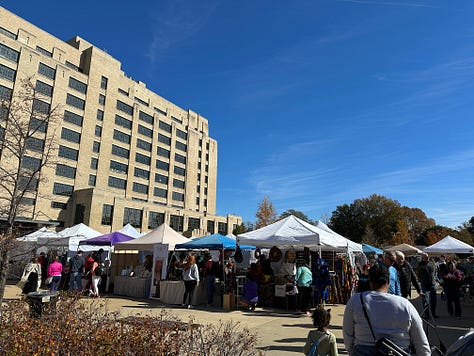
I woke up slow the next day, but it was Mid-November, the sun was shining, and the temps were creepin’ into the high 60s before noon (for those that don’t know, the south in late fall and early spring is nothing short of magic). My Airbnb was centrally located in Midtown and Overton Park was the easy choice for a morning run. Despite housing an art museum, the zoo, and a golf course, my hopes of a sprawling southern park with oversized oak trees draped in Spanish moss, like Audubon or City Park in New Orleans did not materialize. It felt ordinary and underwhelming.
Afterwards, I trekked a couple miles Northwest to the Crosstown Concourse – an art deco building spanning a city block that was previously a Sears retail store and a store catalog plant. Besides a few nice homes that survived the strip mall development, the walk was desolate and rather harsh. Mostly sidewalks full of broken glass and trash, leading past gas stations and chain stores in decline. I walked past a billboard that read “Don’t… Real Men Don’t Murder.” It had a picture of black man on the left and a hand holding a gun on the right. While I’ve visited and lived in many cities with high rates of crime, violence, and murder, this was the bluntest approach I’d ever seen to stopping it. There was no sugar coating it, just a reminder when you drive down the street that murder is not the answer.
I arrived at the Crosstown Concourse during a Saturday market, and it was already poppin’ at 11a.m. People we’re lined up at the beer tent while merchants sold art, clothing, knick-knacks, housewares, and food. These kinds of gatherings, even if they don’t always suit me, feel like the seedlings of a city revitalizing itself. Utilizing a building that would otherwise be torn down or left to decay was instead hosting artists of all forms, I could feel a community reinvigorated. And they were drinking before noon. When searching for fun, and people who could lead you to it, always be on the lookout for these telltale signs.
I’d now been in town for about 15 hours and had yet to eat any BBQ. Luckily my place was just a couple blocks from the Bar-B-Q Shop, one of several highly touted, old school spots in the city. During a busy lunch rush I was able to sit at the counter. The prized meat of Memphis BBQ is pork, so I ordered the half-and-half which came with the BBQ pork and something only this spot does – bar-b-que spaghetti. Honestly, this didn’t sound particularly appealing, but when it’s the thing they do, one must try. It was rounded out with BBQ beans, slaw, and Texas toast.
The spaghetti is quite literally BBQ sauce on spaghetti, with a little BBQ meat mixed in. It’s not terrible, but there’s probably a reason it’s not common. However, the pork was delicious and perfectly done. But the sides are what always stand out to me. The Texas toast was thick and perfectly soaked through with butter and proved to be a better vessel for the spaghetti’s BBQ sauce. The slaw had the perfect touch of tang and crunch, but as usual, too small a portion. And the BBQ beans were divine and simple – a touch of sweet and with a rich buttery backdrop. Coupled with a few lagers, it’s a hard meal to beat.
The guy to the right of me was clearly local and preaching some favorite menu items to the couple at his other side. We started chatting and I told him I realistically had one more BBQ joint I could hit on this trip – should it be Payne’s or Cozy Corner? Along with The BBQ Shop, these were the names that consistently show up as the best in the city. He was having trouble picking when the owner Eric walked by. He stopped Eric, got him up to speed on my situation and the in-depth discussion began.
Eric is the man. He’s stout, maybe 5’ 8”, naturally big, but muscular. Like a retired power running back. He’s a got a shaved head and round face with a big ass smile. Ultimately, he recommended Payne’s but said I can’t go wrong with either. He told me there’s nothing but love and respect between BBQ families in Memphis and went so far as to tell me, “If the Payne family walks in right now, I’m kissing the ring.” He even told me a story from a few years back, his aunt had gone into a coma on the same day as his parents 50th wedding anniversary. After a family visit to the hospital, they all ended up getting Payne’s to-go and eating their smoked sausages (his favorite) right in their car as a family.
Eric came back by as I finished, making sure I enjoyed the meal and asked what else was on my agenda. He suggested a few spots for music and verified hitting Wild Bill’s was solid and that I would be fine going there alone. Then he looked me up and down and said “oh wait, you said you lived in New Orleans. You know what you’re doing.”
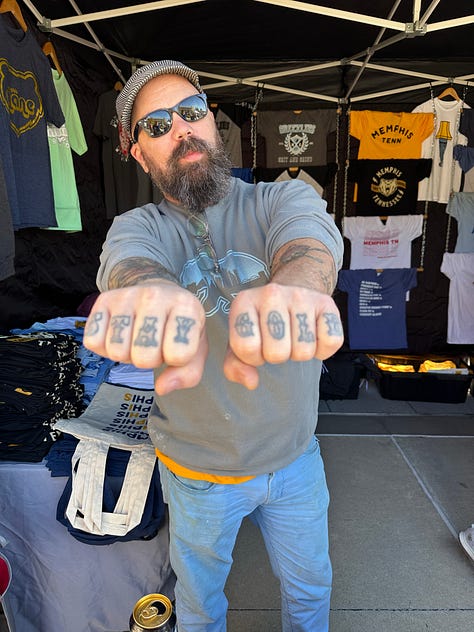
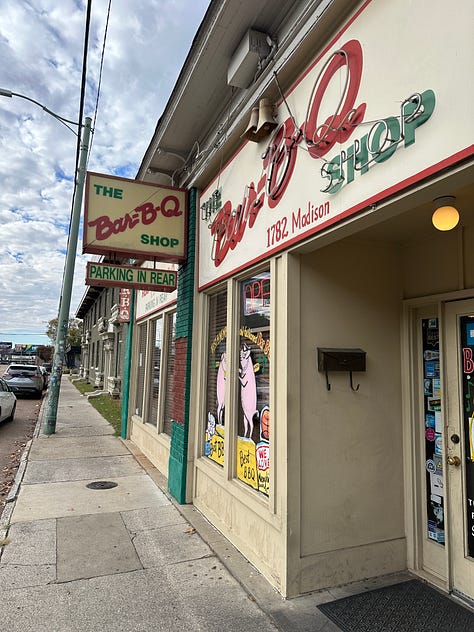

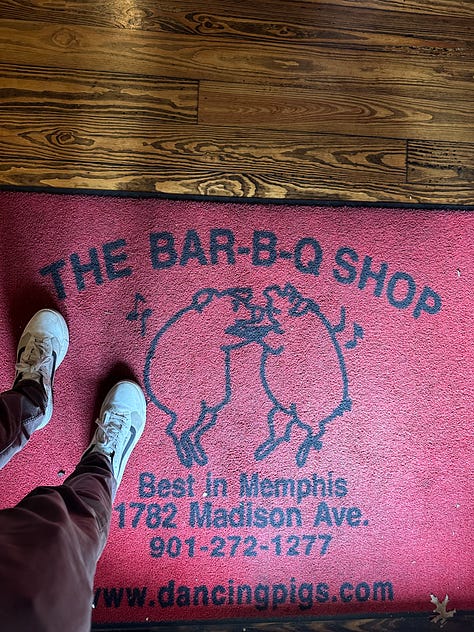
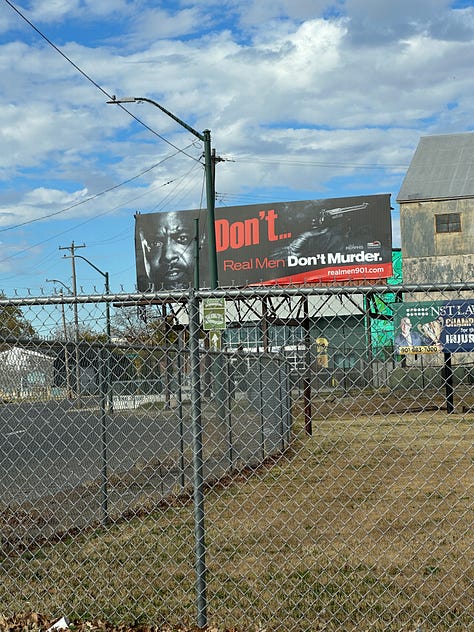

My next stop was the National Civil Rights Museum. It’s in the restored Lorraine Motel, the site of Martin Luther King Jr’s assassination. It’s astoundingly cool that they turned the scene of such a tragic, landmark event into a necessary museum, rather than letting it fall into disrepair and be torn down.
Too often the Civil Rights Movement gets boiled down to only Martin Luther King Jr, and then he’s simplified into his “I Have a Dream” speech. But the Civil Rights Movement was vast and intricate beyond MLK, though he was the face of it for periods during his life, and since.
And he contained multitudes – he was a small town preacher (Montgomery, AL) thrown into his first leadership role during the bus boycott (in what was expected to be a local campaign that soon gained national attention) because no one else stepped up; he was arrested and beaten many times in his career, both because he was hated and also because putting himself in harm’s way garnered attention when the movement was in a lull; he was a married man and philanderer; he was tortured by this failing that juxtaposed his lofty goals for an entire nation to be better; and his star was waning before his death as he moved beyond race towards the Poor People’s Movement. There’s so much more complexity about him though and this read by Marshall Frady is compelling and quick. I highly recommend it as a fuller picture of the man we all celebrate but who few know much about.
The Poor People’s Movement was what led him to Memphis – to work with the striking Sanitation Workers Union in the city. And it also led to maybe, his best speech “I’ve Been to the Mountaintop.” If you listen to that and don’t get goosebumps, teary-eyed, and a jolt of rage and energy, you are not alive. At this point, he was either clairvoyant and foresaw his death coming the next day, or, having had his life threatened so often, he had simply reached a point of acceptance that it was near. He states that “I might not make it there with you, but I’ve seen the mountain top.” It’s a wild line considering he was killed the next day.
The museum itself is an intimate deep dive into the movement. My only knock would be that it sometimes it felt out of chronological order, but it may have been the tight quarters that disoriented me. Nevertheless, the history is undeniable, and the fact that you get to walk up and see the balcony and two rooms (behind glass) that MLK and his entourage occupied during their stay is chilling.
It's a heavy place to visit and I left a bit out of sorts. I went a few blocks over to WiseAcre Brewing to take the edge off. What a wild contrast it was – high ceilings with a massive open bar room donned with bright, happy colors across the walls. I stayed for a beer before heading home for a quick reset.
Dinner would be at Alex’s Tavern – a hole in the wall in a mostly residential section that gets heaps of praise as a neighborhood institution with great bar food. It’s unassuming as ever with a simple red awning and several neon signs in the windows. The inside is comfortable darkness lit by a few lamps, more neon signs, a few televisions, and multiple jukeboxes. A few tables occupy the floor, but the best seating is at the bar. A cigarette machine, shuffleboard, and a golf game round out the set up.
It was a slower night, so a question or two in, and the bartender Wynn was giving me all the details on the place and Memphis too. While Alex himself had passed, (the bar opened in ’53), his son Rocky took over the joint and tried to keep everything the same. The only difference was changing out some music in the jukebox, something he’d tried to do as kid. Wynn liked to say he was just the busboy of the joint though it was clear he’d been running the front end efficiently for years.
I put back a few $4 High Life’s (no liquor here - an odd thing to see in a city that lets you smoke in bars) and ordered their Famous Greek burger. The Cavender’s Greek seasoning gives it its unique twist, but the whole thing is thoughtfully made. It’s a perfectly sized, hand-formed patty cooked medium, pink inside with a light char out, and the condiments – mustard, pickles, onion, and tomato – are all necessary, there’s no added distractions.
Too many burgers come topped with the saddest tomato slice - a dull red skin, translucent inside, with a hard white center. It’s almost assumed that you’ll have to dismantle the burger to remove the flavorless, limp cardboard wheel before starting your meal. The Greek Burger though had a single fat slice of tomato on there that changed the game. It was November and it was still straight from the garden – juicy, rich, and blood red – the type you can happily eat with just a little salt and pepper. It was a burst of earthy delight, a profound replacement for ketchup.
The Soul Burgers at Hazel’s get the hype and they are a wonderful drunk snack that won’t weigh you down, but Alex’s Greek Burger was easily a top-10 all-time burger, and I’ve eaten entirely too many. I don’t know if it was my praise, but I was quickly gifted 6 wings, the rivaling menu item. The wings hit hard too – cooked to a crisp outside but sliding off the bone with the most minimal effort. They were the right mix of heat and sweet, but the buttery base came to the forefront, making for a more savory flavor. As I ate, Wynn nudged my beer closer, “Not forcing it,” he said, before helping another customer.
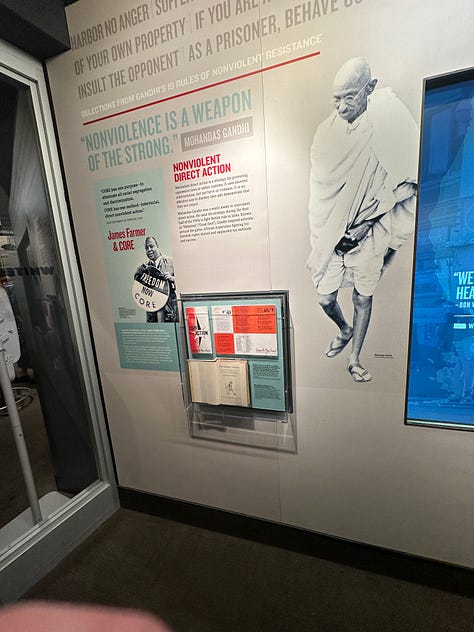
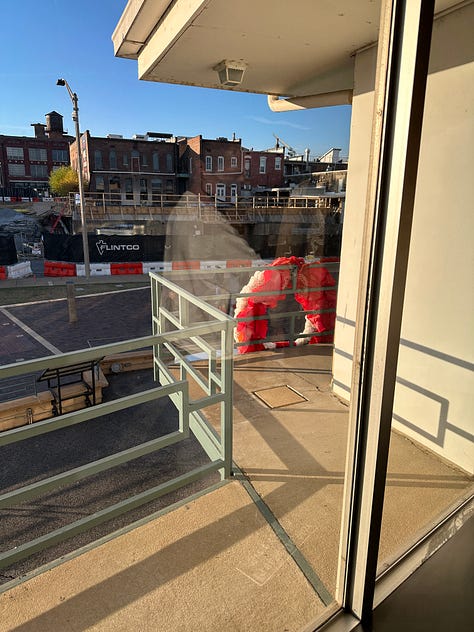
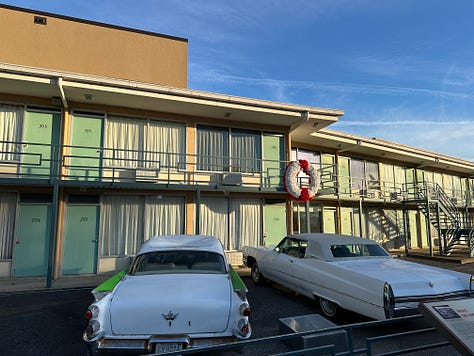
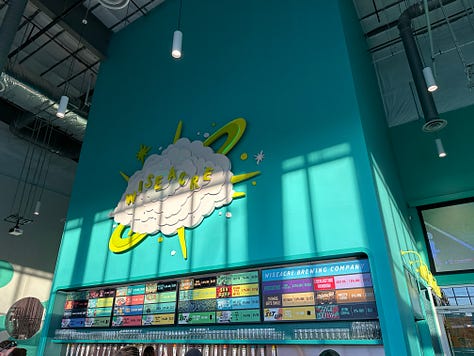
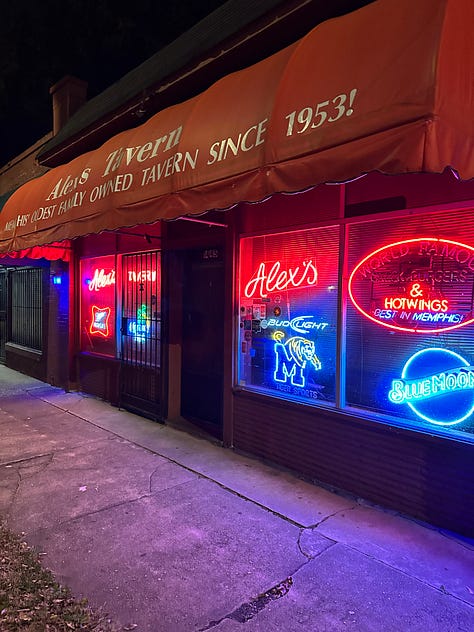
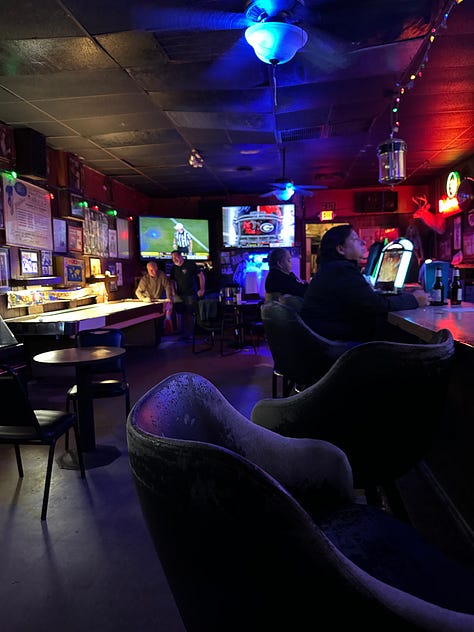
All this food was cooked in a Frankenstein kitchen/office set up by the owner himself, Rocky, who came out to chat with me for a bit. Before I set off, they tried to send me home with a Rubbermaid vat of Gumbo. Once I explained I had no car and more night ahead, they told me to come by and the next day and pick some up.
Wynn and the Alex’s Tavern team are the reason to visit these cities and the institutions in them. The locals have such genuine pride for their city and are so eager to share it. When I get the chance to speak with them, they’re always surprised that I’m there, and shocked I’m alone. It’s an uncommon occurrence for them to get visitors there looking to explore and understand the city. It’s usually people in town for work, a convention, or family. When it’s a visit for the city, they want to prove their worth. They were beyond gracious and I felt the Memphis love.
I walked through a mile stretch of poorly lit neighborhood with very little traffic. I never did figure out if I should have been walking there at night. Eventually though, there was some hazy light and the low rumble of music coming from a little strip mall. The parking lot was full, Wild Bill’s was goin’ off. As advertised, it was a hotspot for authentic Memphis blues. The building is windowless with Wild Bill’s written in giant letters on the front with a small open sign below. With the façade shaking it, it was a given.
The front door opens to a phone booth sized space with another locked door, I hit the buzzer. The door unlocked to a man collecting a $20 cover and stamping hands. The venue was odd, a wall went halfway through cutting it into two long and narrow spaces before opening in the middle. It was like a small banquet hall filled with folding chairs and cheap plastic tables, some with tablecloths, some bare. Definite VFW Hall vibes. I began second guessing what I was doing – could this be a wedding or a private party? Everyone was well dressed, and any unoccupied place-setting was filled with the belongings and plates of someone on the dance floor. And everyone was black.
I caught a few eyes but, looking like me, it wasn’t a surprise. And none indicated I couldn’t, or shouldn’t, be there. I worked my way to the bar, ordered a Modelo, and floated around. I had expected downright dirty blues, sounds plucked from one of the few juke joints left in the rural south. What played was a fun but more straightforward outfit, fronted by an obese man who sat the entire time. It was too clean of a sound for my taste.
Wild Bill’s is welcoming enough, but I was looking for a place to settle in, give myself a little distance to watch the crowd swilling from red solo cups and dancing up front. Normally, I can saddle up to the bar or tuck away to take in the atmosphere. But here, there were no bar seats, and every table was filled – the place was packed out. Not only was I the one white guy here, there was no place for me to be less conspicuous. Sticking out like some yuppie Yelper led astray, I stood in the center of it all. To top it off, I couldn’t lose myself in the music. I was hyper aware of feeling out of place.
To feel foreign when traveling internationally is the expectation. To feel out of place when you’ve gone outside your comfort zone is common. To feel both when you’re at home, doing a routine activity, that’s a new level of unfamiliarity for me. It should not have been a surprise to feel that way though, in my day-to-day everything takes place in settings where the stock white guy is the prevailing figure. This was not that.
Nothing was sketchy about my situation, but I felt like I didn’t belong. In the vast, predominately white stretches of America, is that what every person of color feels? Can you eventually become numb to it, or does that awkward feeling always sit in the back of the mind when venturing out? My reality is that I’d rarely felt that, and never considered it as a constant for others. But Memphis seemed to have a knack for continually forcing contemplation on race and belonging.
After bar hopping a bit, I ended up back at Earnestine & Hazel’s. Another soul burger and a few High Life’s were in order as I watched another band perform for an audience as diverse as the night before. After which, I gave in to sleep, making way for my final full day.
The next morning, I ran my hangover through the Cooper-Young neighborhood. It was pleasant with well-maintained ranch and craftsmen style homes, some modest others massive, though never appearing as extravagant wealth. And it was evident there was some fun to be had on Cooper St., where a stretch of blocks was lined with bars, restaurants, and window shopping. But something was noticeably off - it was really quiet. Nothing was open, and no one was out. Where were the gaggles of brunch lovers and football fans on a beautiful fall day in this hip neighborhood?
Back at my rental, I was still deliberating between Cozy Corner and Payne’s for my second BBQ outing. When I looked up Cozy Corner’s address, I saw they were closed on Sunday. Not a problem, with Eric’s ringing endorsement for Payne’s, I would be just fine. I looked it up – also closed on Sunday. It finally hit me. Duh, the COGIC convention wasn’t here randomly, this was a church first, old school southern city. Everyone was at church. And most businesses would remain closed for the day. Sunday was looking slow.
Luckily, lunch took a back seat anyway, I had a 12:30 Sun Studios tour. It’s an easy and entertaining 45-minute tour of the original space that includes the front offices and recording studio itself. They even moved the old WHBQ radio station that Dewey Phillips (an influential DJ and friend of owner Sam Phillips’) worked at, putting it in the second story of the building.
Sun Studios began with black artists like BB King and Howlin’ Wolf and takes credit for recording the first rock ‘n’ roll song – ‘Rocket 88’ by Jackie Brensten (with Ike Turner on keys). But it’s perhaps most famous for being the place that launched Elvis’s career and where label-mates Johnny Cash, Jerry Lee Lewis, Carl Perkins, Roy Orbison, Conway Twitty, and so many others recorded hits. Its epic history is housed in a very modest space complete with the old ribbon microphone and piano used in several of the biggest recordings. They’re available for any tour-goer to see and touch. It’s about as easy of a guided tour that you can get, which I’m all about.
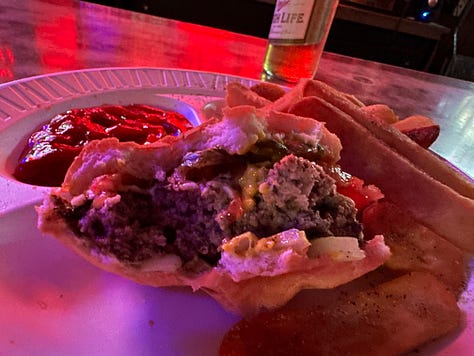
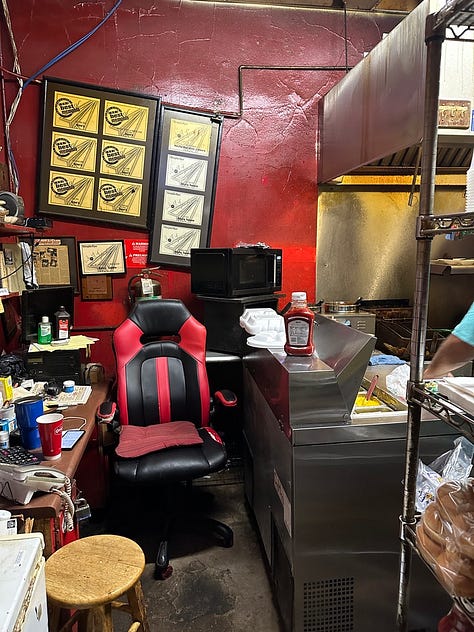
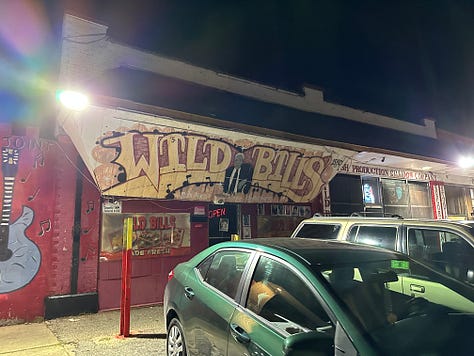
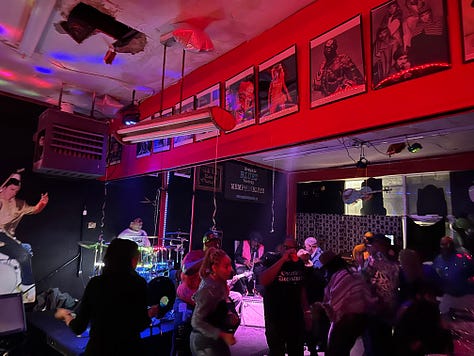
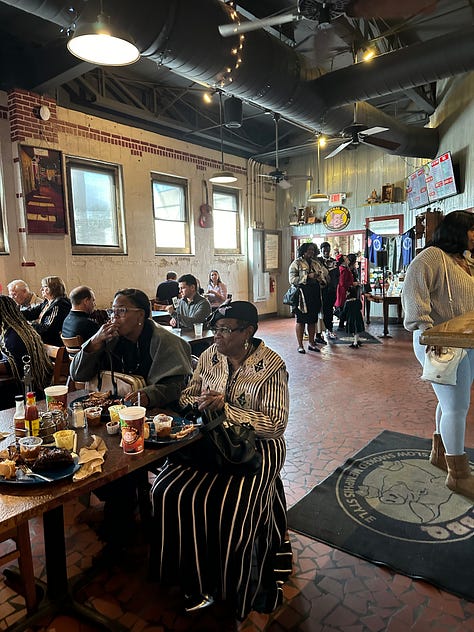
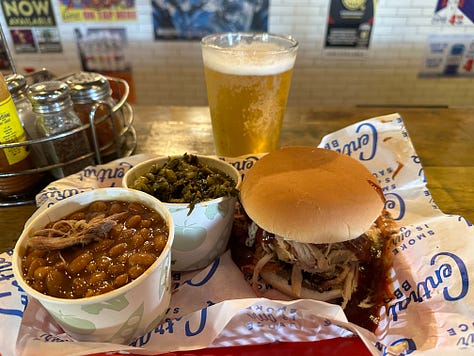
Lunch was now a must, so I hopped on a city bike (always see if your destination has shared bikes, and always take them if they do) and went to Central BBQ. It’s another touted joint but one that’s been franchised out, so while the food still hits, the charm of a hole in the wall spot has been replaced by the clean sheen of cookie cutter efficiency. But hey, it meant they were open on Sunday, good enough for me.
Central BBQ was alive with the buzz of families ready to celebrate with some family style food. The food was great – a pulled pork sandwich, collard greens, and barbeque beans. But what stole the show was everyone in their Sunday’s Finest after church. Let’s be honest, white people and black people do church very differently. You don’t even have to attend either to know this, just walk by each in session or letting out and you’ll feel the difference. White church is often stuffy, somber, and a total buzzkill. Black church is uplifting, loud, and entertaining. And the outfits reflect that. Nothing better than seeing grannies looking better dressed with more flavor than any trendsetting fashionista.
I took my city bike to the riverfront and rode north before parking it at the last outpost by the water. My destination? The eyesore that is the Bass Pro Shops Pyramid. It dominates the riverfront and even the skyline from the air. It’s the most grotesque and American piece of architecture I’ve ever seen, and I had to get up inside it. It occupies a huge piece of riverfront land with what seems like a half mile of roads and parking lots to get to it, a mess for a pedestrian. It embodies the American Dream and reality that everything should take up as much space as possible, and it should be built exclusively for those with cars. It’s acknowledgement of foot traffic was laughable. But I’ll walk your unwelcoming labyrinth of ugly lots beneath overpasses to be welcomed to “Sportsman’s Paradise” just the same as all the families packed into their Ford f-250s.
Boy did this emblem of Americana does not disappoint. Almost immediately after walking in I heard one man say, “it’s unbelievable this is the inside of the pyramid!” Right after, a man with his friends shouted, “no fucking way” as he craned his next up to take in the full monstrosity. It’s a mashup of a cheap all-inclusive resort, a bad theme park, and Mall of America, focused on hunting and fishing. It’s as though they took a Bass Pro Shop retail store and then built a theme park around it with the scraps from a Jurassic Park ride at Universal Studios. There are bridges over ponds full of catfish, enclosures with alligators, arcade games, and boats, all while you shop for sunglasses, hats, vests, fishing rods, and kayaks.
Hit the bar at the Mississippi Terrace and enjoy some live music. Take the family up the world’s tallest freestanding elevator to the Observation Deck for views of Memphis, followed by lunch at the Lookout. While the kids go shoot at the archery range you and the wife can buy some new berettas and test them at the pistol range. Take in the daily fish feeding at 2p before retiring to your room for a catnap in the 103-room Big Cypress Lodge. When you awake from your slumber, you’ll be ready to dine at the wilderness-inspired Wahlburgers Wild, followed by family bowling night at the 13-lane Fishbowl. Or just shoot some more guns. It’s all at the Pyramid.
My exit from the Pyramid land mass was equally unfriendly on the way out. I eventually worked my way back downtown – I had time to kill and no one where to go. With the city sleepy as ever at 4p.m., I popped into the Peabody Hotel. In an hour’s time they’d be doing the daily Peabody Duck March. Yes, somehow this is one of the biggest tourist attractions in Memphis.
See, back in the 1930’s the GM at the Peabody, Frank Schutt, had come back from a hunting trip with the boys and, while getting drunk on whiskey, decided to place a few of their live decoy ducks in the lobby fountain. They laughed and drank but the ducks got comfortable quickly. Fast forward a few years, the ducks continued spending daytime in the fountain and were eventually trained to exit and “march” to the elevator, riding it back to the rooftop where they reside.
This quickly became a tradition, and now, somehow a huge tourist attraction. The ducks swim in the fountain daily from 11-5p.m. By 4p.m. people begin to pack into the hotel lobby, eagerly awaiting the Duckmaster who presides over the whole show. With an open evening, and my curiosity for American tourism piqued, I claimed a bar seat and ordered an old fashioned.
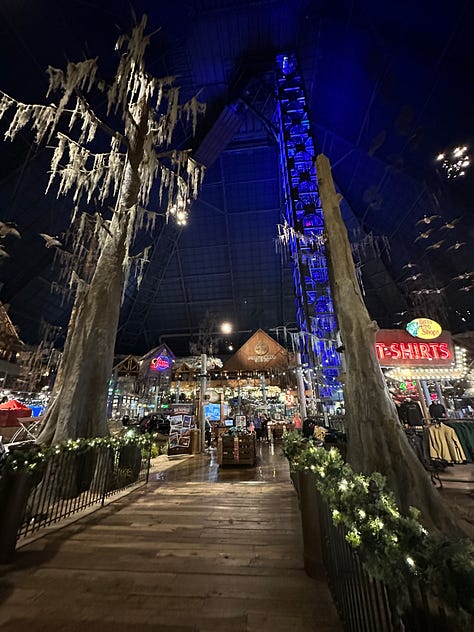
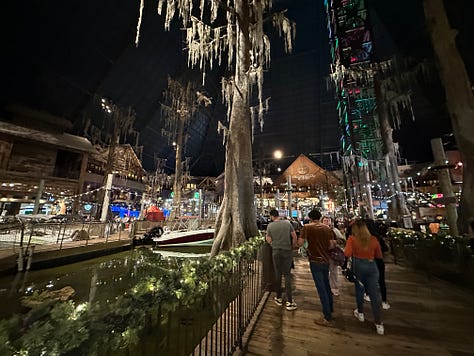
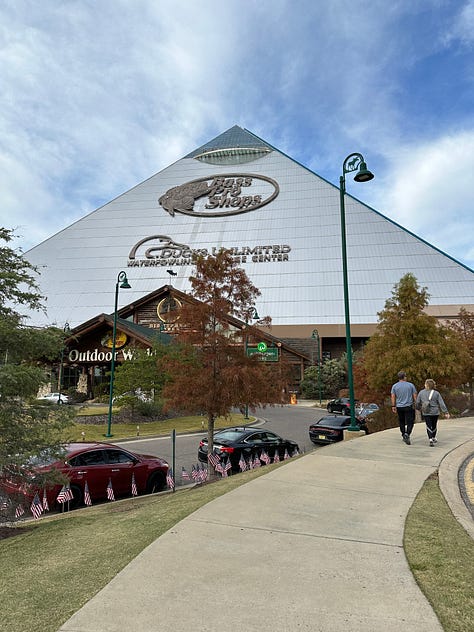

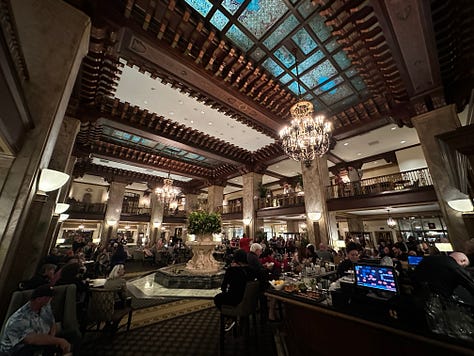
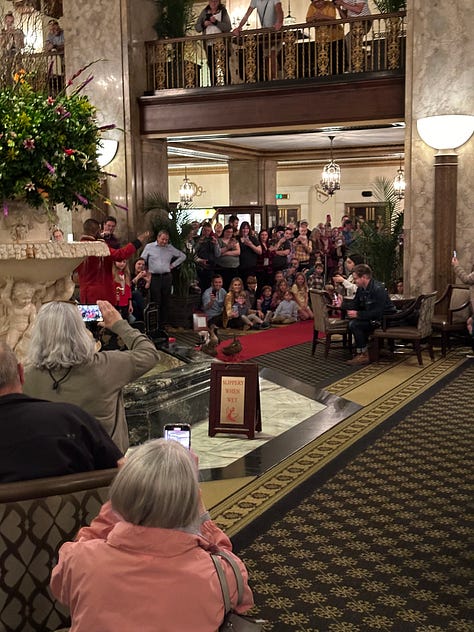
I came knowing very little, only that it’s one of the big tourist draws when you start looking up “what to do in Memphis.” The scene is a patchwork of families in their church clothes, old folks, and tourists, all delighted by this display. Bright colors, perfectly hemmed dresses, and church crowns brushed shoulders with the drab outfits of septuagenarians, and a smattering of t-shirts, denim, and Hokas from out-of-towners. As we inched closer to 5p.m. the buzz kept growing – people next to me talked about how they’d come each evening during their trip.
Was this daily demonstration more exciting than I knew? I asked my waitress.
She smiled knowing this wasn’t my kind of entertainment, “Around 4:45 the Duckmaster will start speaking, he’ll roll out the red carpet, start gathering the ducks, and walk them to the elevator.”
Nope, probably not any more exciting than I envisioned. But now every seat was taken and there was a standing crowd filling out the rest of the lobby.
The Duckmaster, dressed like a distinguished bellhop, draws everyone’s attention like a tour guide. He spoke in detail about the history of the hotel and tradition, making jokes along the way and captivating his audience, though in truth I can’t recall anything he said. Somehow this display goes on for 25-30 minutes – eventually though the ducks leave the water and gather at the foot of the fountain. With the help of some kids in the crowd, the ducks are corralled, and marched down the red carpet to an open elevator door.
That was it. A half hour of waiting followed by another half hour of buildup to watch ducks walk 20 feet. I even asked, “Is that it?”
My waitress gave me an I-told-you-so glance, “That’s it,” behind a little laugh.
Despite that, the fans across the lobby seemed absolutely tickled by the whole scene. The Duck March, it seemed, had as much allure as the well preserved, and still culturally relevant history on display throughout the city.
In many ways, that sums up Memphis. With the glaring contrast of the Pyramid aside, the city leans on history and tradition to entertain. I’d never done so many tourist activities during a weekend trip. The history is so rich, there’s a desire to connect with those peak years and see formative moments of this city and country up close. But with a lack of new, relevant excitement to explore, you’re not left with many other choices.
Memphis feels trapped under its own shadow. At times I felt like I was on the set of a period piece filmed in the 1950’s and 60’s. Storefronts and restaurants feel quaint and untouched since they first opened. There are beer-only bars and indoor smoking is allowed. An older generation still dressed the part, going to church and bringing the younger generations with them. It’s a delightful throwback. But the mental state of Memphis seems stuck there too – the issue of race was omnipresent.
It creates a unique contrast and backdrop for travel. You can get a taste of another era and feel like you’re being placed back in time. But with it comes an unnerving reality – it’s 60 years later and some of this supposed history is our present — we’re still living and grappling with it, still trying to solve for it. While most cities across the country are adept at leaving out their uncomfortable truths entirely, Memphis can’t and won’t.
Is it then intentional that Memphis has not moved on from that era, acting as a reminder to us of some unfinished work? Or has it been left behind by the rest of the country because of that stubbornness — another great American city that’s been allowed to drift into slow decline? I like to think that it can continue that past work and also foster the seeds I saw firsthand to remake itself as a cultural hub. Regardless, I’ll at least have another bit of history to explore next time I’m there, because no, I didn’t go to Graceland.


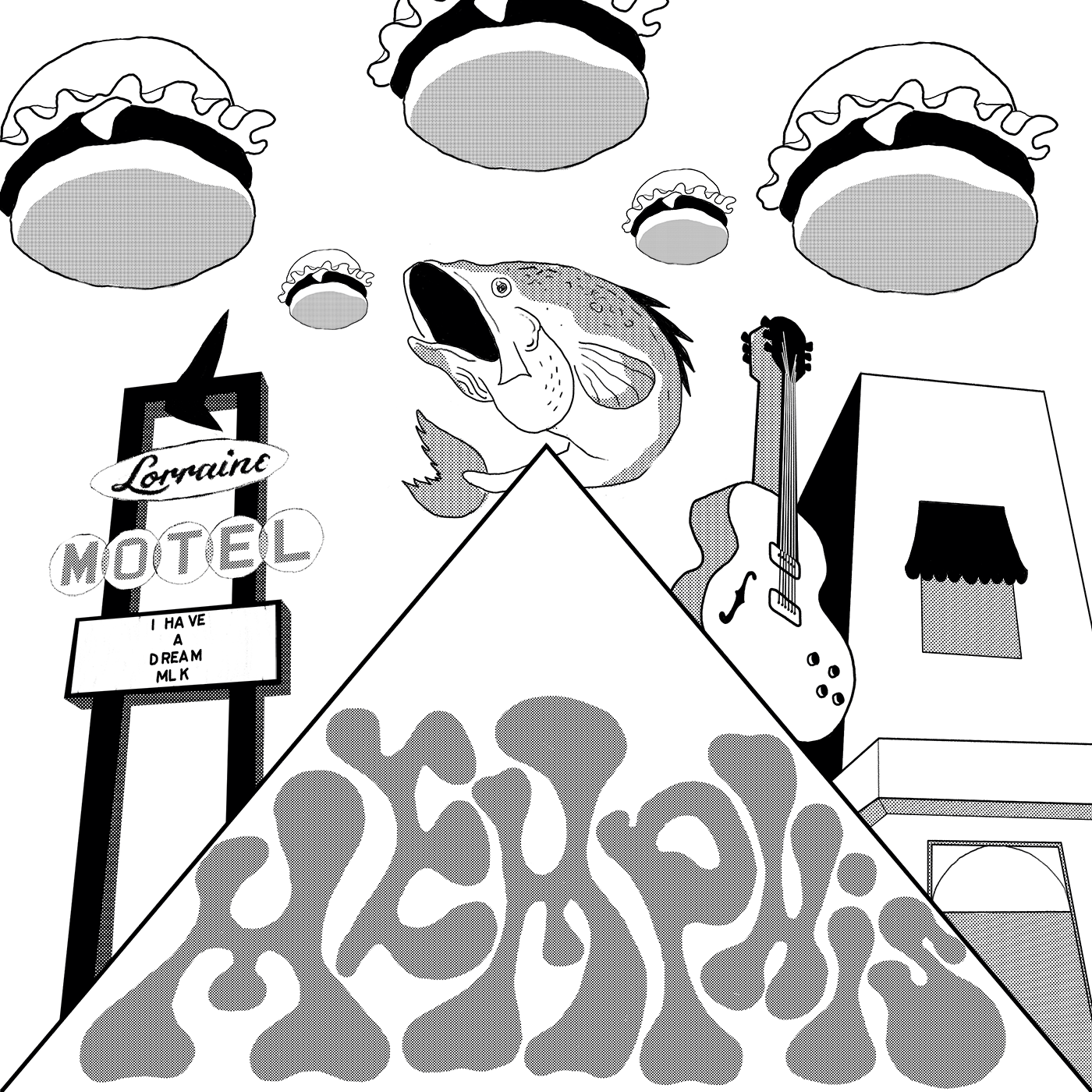
This was great, Custer. I was born in Memphis and my mom's family is all from there, so I really enjoyed reading your (accurate, I feel) perspective about the city's state, being stuck in the past, etc. Memphis has always been a good time, but it's also a little depressing because of what it once was.